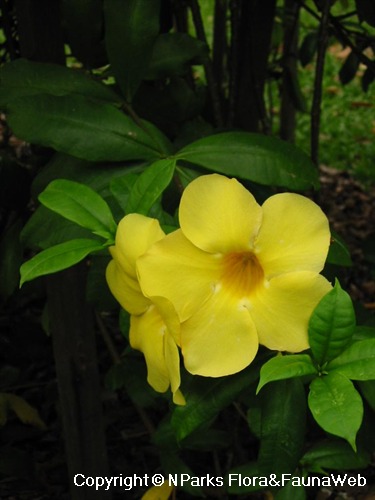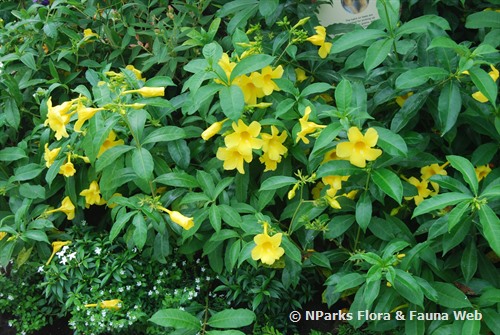.jpg)
Back
Allamanda cathartica L.
| Family Name: | Apocynaceae |
| Common Name: | Allamanda, Golden-trumpet, Common Allamanda, Yellow Allamanda, Akar Cempaka Hutan, Bunga Akar Kuning, Akar Chempaka Kuning, Allamanda Trumpet Vine, Golden Trumpet Vine, 软枝黄蝉 |
Allamanda (Allamanda cathartica) is an evergreen tropical climber with large, deep yellow trumpet flowers and glossy green leaves. Native to Brazil, its flowers are visited by bees, sunbirds and butterflies. Allamanda makes a lush addition on trellises or fences in parks and gardens and flowers freely all year.
Name
Classifications and Characteristics
| Plant Division | Angiosperms (Flowering Seed Plants) (Dicotyledon) |
|---|---|
| Plant Growth Form | Climber, Shrub |
| Lifespan (in Singapore) | Perennial |
| Mode of Nutrition | Autotrophic |
| Maximum Height | 3 m to 6 m |
| Maximum Plant Spread / Crown Width | 1 m to 2 m |
Biogeography
| Native Distribution | Brazil |
|---|---|
| Native Habitat | Terrestrial |
| Preferred Climate Zone | Tropical, Sub-Tropical / Monsoonal |
| Local Conservation Status | Non-native (Spontaneous (Naturalised)) |
Description and Ethnobotany
| Growth Form | A woody and evergreen vine. It can grow up to 6 m long. |
|---|---|
| Foliage | The leaves are borne in whorls along the stems and are leathery and oblong-lanceolate in shape, grow up to 16cm long and 6cm wide. |
| Stems | Woody and twinning stem. It contains milky sap. |
| Flowers | The yellow, funnel-shaped flowers are borne in axillary cymes. The flowers sepals are ovate to narrowly ovate, the flower corolla is yellow and 5-lobed and spreading. |
| Fruit | The fruits are in the form of prickly capsules which split open to release winged seeds. |
| Others - Plant Morphology | All parts of the plant have white milky sap that may cause rashes, itch, and blister once expose to it. |
| Habitat | It is commonly found in disturbed areas, forest margins, near swamps and roadsides. |
| Cultivation | This plant flowers best under full sun. It can be trained to climb on support such as trellis. Occasional pruning is required to promote air circulation to reduce fungal attack on leaves. |
| Etymology | The genus Allamanda is given after Dr. Frederick Allamand. The specific epithet cathartica means cathartic, cleansing, purging which refers to its medicinal purpose in inducing vomiting. |
| Ethnobotanical Uses | Medicinal: In the tropics, it is used as a purgative and to induce vomiting in low dosage, as a high dosage can be toxic. |
Landscaping Features
| Landscaping | It can be grown as climber on trellis, fence as well as shrub in container planting. Here in tropical area, it is often grown as a hedge. |
|---|---|
| Desirable Plant Features | Ornamental Flowers |
| Landscape Uses | General, Trellis / Arbour / Pergola, Hedge / Screening, Container Planting, Parks & Gardens |
| Thematic Landscaping | Golden Garden |
| Usage Hazard - Cons | Irritant - Sap, Toxic Upon Ingestion |
Fauna, Pollination and Dispersal
| Fauna Pollination Dispersal Associated Fauna | Bee-Attracting, Bird-Attracting (Flowers), Butterfly-Attracting |
|---|---|
| Pollination Method(s) | Biotic (Fauna) (Insects (Bee)) |
| Seed or Spore Dispersal | Abiotic (Explosive Dehiscence) |
Plant Care and Propagation
| Light Preference | Full Sun |
|---|---|
| Water Preference | Moderate Water |
| Plant Growth Rate | Fast to Moderate |
| Rootzone Tolerance | Moist Soils, Well-Drained Soils |
| Pest(s) | Sucking Insects |
| Propagation Method | Seed, Stem Cutting |
Foliar
| Foliage Retention | Evergreen |
|---|---|
| Mature Foliage Colour(s) | Green |
| Mature Foliage Texture(s) | Glossy / Shiny, Leathery |
| Prominent Young Flush Colour(s) | Green |
| Young Flush Texture(s) | Glossy / Shiny, Leathery |
| Foliar Type | Simple / Unifoliate |
| Foliar Arrangement Along Stem | Opposite, Whorled |
| Foliar Attachment to Stem | Petiolate |
| Foliar Shape(s) | Non-Palm Foliage (Lanceolate, Oblong) |
| Foliar Venation | Pinnate / Net |
| Foliar Margin | Entire |
| Foliar Apex - Tip | Acuminate |
| Foliar Base | Acute |
Non - Foliar and Storage
| Bark as Host | Conducive (Climbers / Vines) |
|---|---|
| Stem Type & Modification | Woody |
| Root Type | Underground |
Floral (Angiosperm)
| Flower & Plant Sexuality | Bisexual Flowers |
| Flower Colour(s) | Yellow / Golden |
|---|---|
| Flower Texture(s) | Smooth |
| Flower Grouping | Cluster / Inflorescence |
| Flower Location | Axillary |
| Flower Symmetry | Radial |
| Individual Flower Shape | Trumpet-shaped |
| Inflorescence Type | Cyme |
| Flowering Period | Free-Flowering |
| Flowering Habit | Polycarpic |
Fruit, Seed and Spore
| Mature Fruit Colour(s) | Black |
|---|---|
| Mature Fruit Texture(s) | Thorny / Spiny |
| Fruit Classification | Simple Fruit |
| Fruit Type | |
| Mature Seed Colour(s) | Brown |
| Seed Quantity Per Fruit | Moderate (6-10) |
Image Repository
Others
| Master ID | 7 |
|---|---|
| Species ID | 1303 |
| Flora Disclaimer | The information in this website has been compiled from reliable sources, such as reference works on medicinal plants. It is not a substitute for medical advice or treatment and NParks does not purport to provide any medical advice. Readers should always consult his/her physician before using or consuming a plant for medicinal purposes. |


.jpg)











